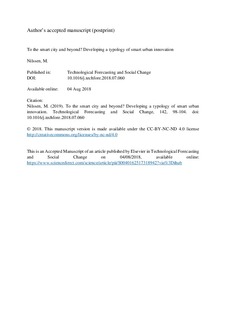| dc.contributor.author | Nilssen, Maja | |
| dc.date.accessioned | 2019-12-05T13:34:20Z | |
| dc.date.available | 2019-12-05T13:34:20Z | |
| dc.date.created | 2018-08-14T12:34:43Z | |
| dc.date.issued | 2018 | |
| dc.identifier.citation | Nilssen, M. (2019). To the smart city and beyond? Developing a typology of smart urban innovation. Technology Forecasting and Social Change, 142, 98-104. doi: | nb_NO |
| dc.identifier.issn | 1873-5509 | |
| dc.identifier.uri | http://hdl.handle.net/11250/2632019 | |
| dc.description | Author's accepted version (postprint). | nb_NO |
| dc.description | This is an Accepted Manuscript of an article published by Elsevier in Technological Forecasting and Social Change on 04 August 2018. | |
| dc.description | Available online: https://doi.org/10.1016/j.techfore.2018.07.060 | |
| dc.description.abstract | The smart city is an increasingly popular topic in urban development, arousing both excitement and skepticism. However, despite increasing enthusiasm regarding the smartness of cities, the concept is still regarded as somewhat evasive. Encouraged by the multifaceted character of the concept, this article examines how we can categorize the different dimensions often included in the smart city concept, and how these dimensions are coupled to innovation. Furthermore, the article examines the implications of the different understandings of the smart city concept for cities' abilities to be innovative. Building on existing scholarly contributions on the smartness of cities and innovation literature, the article develops a typology of smart city initiatives based on the extent and types of innovations they involve. The typology is structured as a smart city continuum, comprising four dimensions of innovation: (1) technological, (2) organizational, (3) collaborative, (4) experimental. The smart city continuum is then utilized to analyze empirical data from a Norwegian urban development project triggered by a critical juncture. The empirical data shows that the case holds elements of different dimensions of the continuum, supporting the need for a typology of smart cities as multifaceted urban innovation. The continuum can be used as an analytical model for different types of smart city initiatives, and thus shed light on what types of innovation are central in the smart city. Consequently, the article offers useful insights for both practitioners and scholars interested in smart city initiatives. | nb_NO |
| dc.description.abstract | To the smart city and beyond? Developing a typology of smart urban innovation | nb_NO |
| dc.language.iso | eng | nb_NO |
| dc.publisher | Elsevier | nb_NO |
| dc.rights | Attribution-NonCommercial-NoDerivatives 4.0 Internasjonal | * |
| dc.rights.uri | http://creativecommons.org/licenses/by-nc-nd/4.0/deed.no | * |
| dc.title | To the smart city and beyond? Developing a typology of smart urban innovation | nb_NO |
| dc.type | Journal article | nb_NO |
| dc.type | Peer reviewed | nb_NO |
| dc.description.version | acceptedVersion | nb_NO |
| dc.subject.nsi | VDP::Samfunnsvitenskap: 200::Urbanisme og fysisk planlegging: 230::Urbanisme: 237 | nb_NO |
| dc.source.pagenumber | 98-104 | nb_NO |
| dc.source.volume | 142 | nb_NO |
| dc.source.journal | Technology Forecasting and Social Change | nb_NO |
| dc.identifier.doi | 10.1016/j.techfore.2018.07.060 | |
| dc.identifier.cristin | 1601909 | |

